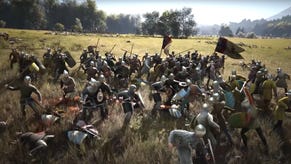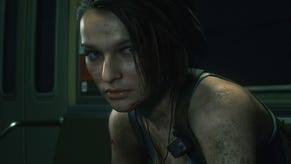Happy Action Theater used in school for special needs students
How Double Fine's Kinect game succeeded where others failed.
Last month we investigated how Minecraft was being used in classrooms all over the world, but it's far from the only mainstream game adapted to education. The Jackson School in Victoria, Australia, which specialises in kids with special needs, has found success using Double Fine's Kinect-exclusive Happy Action Theater.
Double Fine's goofy improvisational interactive green-screen offers players the chance to play around with silly props projected onto the monitor. It may not have the depth or breadth of Minecraft, but it serves a different purpose in Jackson School.
First and foremost, it helps the students socialise - something that doesn't come naturally to several of the 9 - 12 year olds with autism in teacher Emily Ford's class.
"With autism these kids have issues with verbal language, so getting them to talk is one of the things we're trying to do all the time," Ford explained to me over Skype. "So when they've got a bird sitting on their head [in the game] or they're feeding birds they're talking as well. It might be one of the staff saying, 'Oh look Jonas, there's a bird on your head.' And they'll say, 'Oh look, Annie, there's a bird on your head.' They'll talk and make the connection between what they're doing on the screen and actually speaking it."

"They wouldn't necessarily talk to each other unless they had this medium to do it through," she added.
It helps with role-playing too, Ford noted. "In another game they're monsters and they're knocking down buildings, so they'll take on that role." The visual stimuli of the game helps them make this connection. "It's a bit harder to get out and say 'we're monsters now.' So they're acting it out on the screen and getting really engaged, which is exactly what we're trying to do in the classroom."
Mathieu Marunczyn, the IT teacher and self-described "big kid" who introduced Happy Action Theater to the school, noted it's been aiding kids with their physical development, too.
"We have a new occupational therapist and she works with kids with their physical development - gross motor skills and coordination," he said. "Just the other day she asked if she could borrow it for her kids, so I set it up in her room and she was able to quietly assess kids using the software in the games with really good results."
These benefits are all well and good, but a lot of video games stimulate the player's imagination, are engaging, and encourage socialising. So what makes Happy Action Theater special?
"They wouldn't necessarily talk to each other unless they had this medium to do it through."
Emily Ford, Teacher, Jackson School
A lot of it has to do with the setup. Marunczyn explained that a lot of games have complicated menus that make booting them up a chore, specially when being shared among several students. With Happy Action Theater "you just drop the disc in and a few screens come up, but nothing you have to do anything with" he said.
"Some of the other games take seven or eight screens and seven or eight options to actually get to the game, whereas with Happy Action you just put it on and a minute later it's starting and they're on their way," added Ford.
The game's laissez-faire nature makes it more susceptible to short play sessions, too. It doesn't require logging in, selecting a profile, or even picking up a controller. All you have to do is walk in front of the Kinect and you're in the game. "With other games, I think, 'I haven't got time to set that up. Let's go do something else,'" said Ford.

Currently, Ford's class uses it for a social skills session that lasts about 20-30 minutes four days a week. Additionally they spend another 5-10 minutes in the morning and/or afternoon with it every day. It's also on as a backdrop during lunch as it can simply be left on and kids can get involved in it as much or as little as they like to.
The fact it supports six players helps with that, too. This makes it a far more inviting prospect for larger groups under short time limits, since they don't have to take turns. Ford noted the school had a trial of a Kinect Harry Potter game, but it was only single-player and if someone walked in front of it it would pause the game, whereas Happy Action would simply add the offending parties to the game.
One concern I had with Happy Action Theater was that it's not a goal oriented game, so I wondered if it taught problem solving. Marunczyn said his students are really good at discovering the game's secret actions, like getting their hands to go on fire in the lava level, setting off fireworks or throwing snowballs; all things he hasn't figured out how to do.
"They'll throw imaginary fireballs at me and I'll try to do the same, but I can't and they'll mock me... They feel empowered when they can do something the teacher can't," he said.
And for many of these students that's enough. "The main goal in what I'm using it for is engagement," Ford stated. "So if they're interested in it, then that's the goal."









